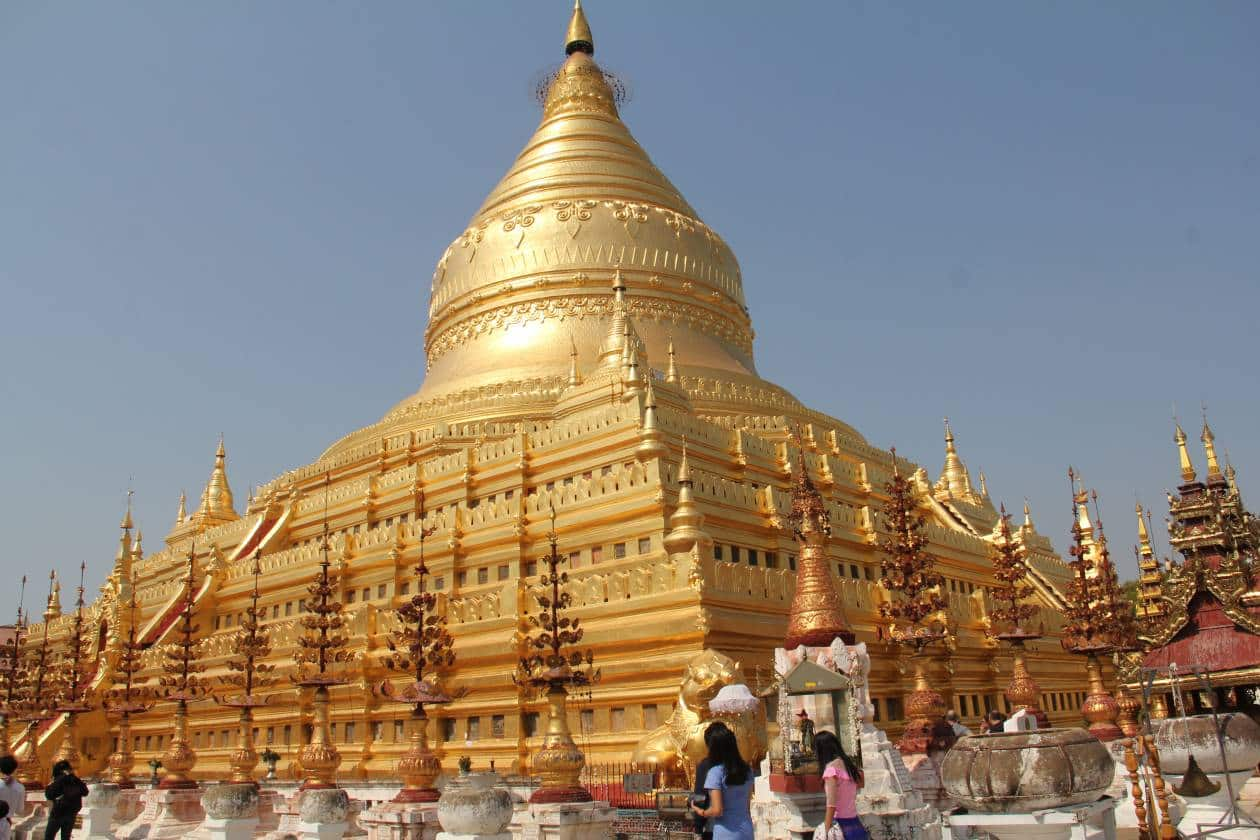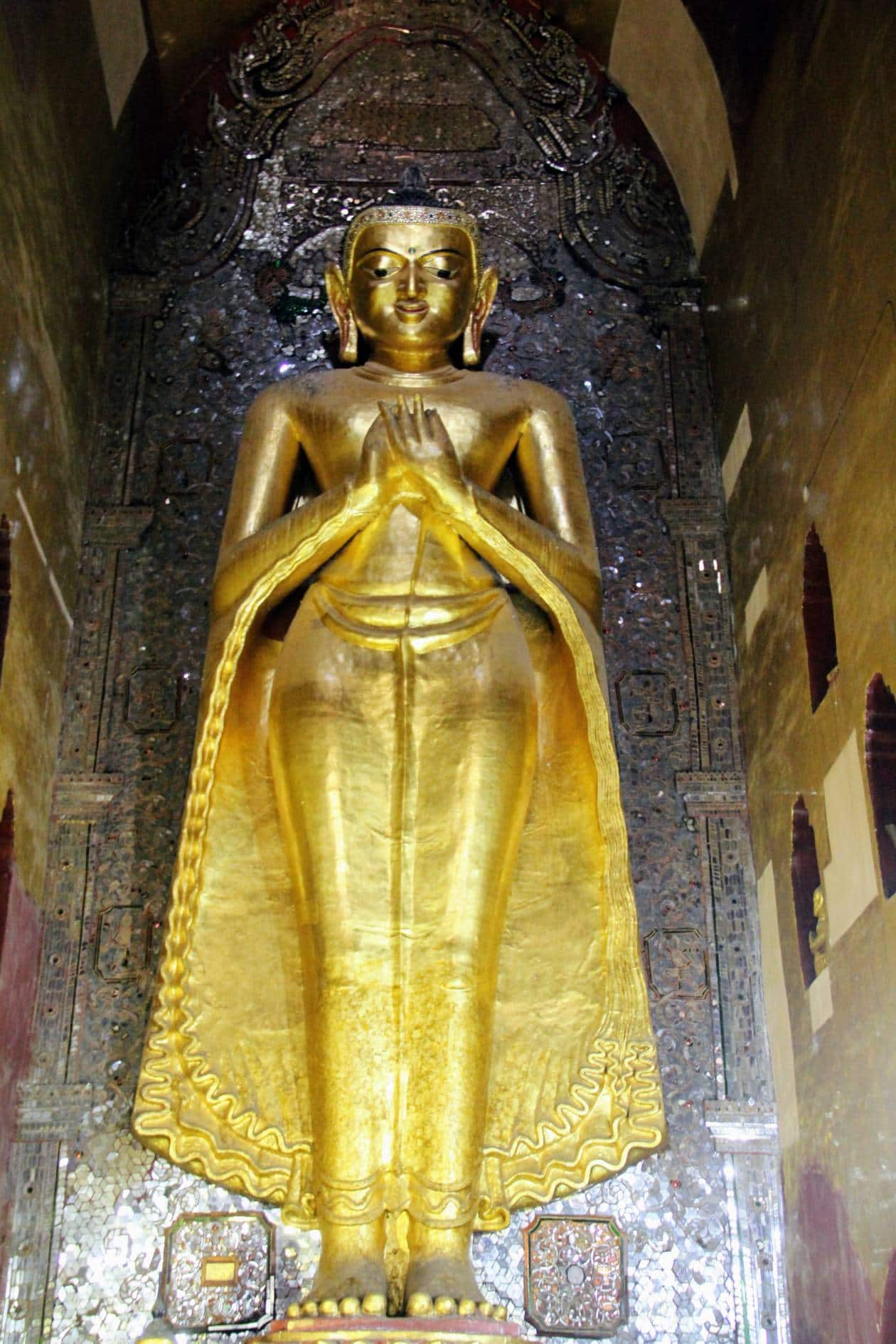



Throw a stone anywhere and chances are that it will fall on a pagoda. From tiny garages or brick kilns to multi-storey fortresses, some small and squat, others soaring gracefully towards the heavens. The red dirt road stretches ahead with spires and some towers, silhouetted wherever the eye can see. I am in Bagan, Myanmar’s Angkor Wat, which Marco Polo once referred to as "a gilded city alive with tinkling bells and the swishing sounds of monks' robes."
Bagan was the Burmese capital between the 9th and the 13th centuries. In its heydays, Bagan was a rich and cosmopolitan place which had trade links with countries like Sri Lanka, India, Thailand and China, and it invested its wealth in its grand religious buildings.
 Bagan was the site of a building-construction frenzy of 55 Burmese kings that lasted for more than 200 years. (Photo: Kalpana Sunder)
Bagan was the site of a building-construction frenzy of 55 Burmese kings that lasted for more than 200 years. (Photo: Kalpana Sunder)
Bagan was the site of a building-construction frenzy of 55 Burmese kings that lasted for more than two-hundred years, when brick, stone and wooden stupas, both simple and grand, were built, transforming the dusty landscape bordering the fertile river valley of the Irrawaddy. At one point in time, over 10,000 temples lined the plains of Bagan but due to pillaging, earthquakes, weathering and the passage of time, only 2,200 remain. Today these crumbling brick and stucco structures are all that remain of their grand city.
Bagan, destroyed by earthquakes and Mongol invaders, is today the centrepiece of Myanmar’s fast-growing tourism industry. It all started with the first Burmese King Anawrahta converting to Buddhism and sanctioning the building of temples. The people believed in the acquisition of good karma through the construction of pagodas and temples; to build a temple was to earn merit.
The ruins of medieval Bagan is called the Bagan Archaeological Zone and sprawls over 67 sq. km. We drive on bumpy dirt roads through small villages and clusters of ruins. Our local guide Aung, tells us how in 1996, the military government forcibly relocated the villagers of Old Bagan, presumably to protect the monuments. The villagers built up New Bagan on a stretch of peanut fields. The villagers are still allowed to farm on their lands and fields that surround the temples and pagodas. Fields of sesame and peanut stretch between ancient structures as cows and goats graze nearby, and tourists on E-bikes turn into small lanes to find a temple.
What makes Bagan so special? It’s its sheer mind-boggling scale, with no walls or arrows telling you which way to go. There are just dirt roads in all directions with clumps of ruins standing defiantly, reached only by thick grass and mud. In 2012, in response to the wear and tear on delicate stairways and terraces, tourists were banned from climbing any of the monuments.
 Brick, stone and wooden stupas were built, transforming the dusty landscape bordering the fertile river valley of the Irrawaddy. (Photo: Kalpana Sunder)
Brick, stone and wooden stupas were built, transforming the dusty landscape bordering the fertile river valley of the Irrawaddy. (Photo: Kalpana Sunder)
We start our temple odyssey at the glittering Shwezigon Pagoda which is also Bagan’s main religious site and supposed to be the prototype for later pagodas built in the country. Shwezigon Pagoda was built to enshrine one of the four replicas of the tooth relic of Buddha, given by the king of Ceylon.
 It began with the first Burmese King Anawrahta converting to Buddhism and sanctioning temples. It was believed that building temples brought good karma. (Photo: Kalpana Sunder)
It began with the first Burmese King Anawrahta converting to Buddhism and sanctioning temples. It was believed that building temples brought good karma. (Photo: Kalpana Sunder)
One of the most stunning pagodas is the Ananda Paya rising to 290 feet. Our guide says, if you haven’t seen Ananda then you haven’t been to Bagan! Built with bricks and plaster, it has tall teak doors, and gargantuan Buddha statues facing in each direction. The temple was built in 1105, with a fusion of strong Indian and local Mon influence. Aung points out the optical illusion — if you are seated at the foot of the Buddha, his expression looks serious, but as you walk farther and farther, he seems to smile down on you!
 Ananda Paya, the Buddha rises to 290 feet. (Photo; Kalpana Sunder)
Ananda Paya, the Buddha rises to 290 feet. (Photo; Kalpana Sunder)
Urban legend has it that the temple’s architects were put to death after its construction, so that they could not build anything rivaling this structure. I love the beautiful murals on the inner walls and the 34 niches in its hallways reaching up to the ceiling, filled with statues of the Buddha.
We learn the small details from Aung, on how to tell an old Buddha from a restored one — “Notice the carved knees and the ears touching the shoulders in the original ones,” he tells us. We look at evocative frescoes that cover episodes in the life of the Buddha and various aspects of local life in those times.
I talk to talented artists peddling images of Bagan and the Buddha painted on paper covered with layers of sand. Burmese puppets hang from trees, and Buddha figurines in a variety of poses from sitting to reclining are lined up neatly to attract visitors. Sweet coconut water and mandarin oranges, revive us in between temple visits, under the hot afternoon sun.
Looming over the landscape, is Dhammayangyi temple one of the largest temples which has a massive square base topped by six receding terraces and reminds me of an Egyptian pyramid. The temple has the unique twin images of Buddha, and the Future Buddha, standing side by side with a beatific smile. The temple hides a dark history though. It was built by King Narathu who, after murdering his father and his brother, was next in line to become King and wanted to build this temple to counter the bad karma that he had created.
The cruel king wanted the bricks to be so close together that you could not even wedge a pin between them, he chopped off the hands of the labourers if they did not succeed . The Dhammayangyi temple was never fully completed. Construction was halted right after the king was assassinated and the interior was filled with construction debris.
 The twin Buddhas at Dhammayangyi temple, Bagan. (Photo: Kalpana Sunder)
The twin Buddhas at Dhammayangyi temple, Bagan. (Photo: Kalpana Sunder)
Just beyond the Dhammayangyi Temple is the Sulamani Pagoda known as the Crowning Jewel. It was constructed by King Narapatishithu, son of the infamous King Narathu. The top of the Sulamani comprises of a shikhara, a tower structure originating from north India. Fine brick-work, terracotta decorations and plaster stucco carvings are seen on the exterior of the temple. Light filters in through vaulted openings, as I catch sight of the walls and ceilings of the pagoda decorated with beautiful ancient murals and frescoes.
Aung points out evocative images of women dancing and combing their hair, a boat being rowed across the ocean filled with lobsters, turtles and fish, and ministers advising the king in a royal court. Painted with organic colours derived from nature, they still grace the interiors, though in patches.
The most enjoyable part of my Bagan trip is visiting lesser-known structures, such as the Khay Ming Gha temple complex with small stupas and temples (including one damaged by an earthquake and tilting precariously to one side, called the "Leaning tower of Bagan") surrounded by bright pink bougainvillea. The Shwe Nan Yin Taw monastic complex is otherworldly, with its many stupas and buildings with trees growing in between. It's desolate and empty and I have the entire complex to myself. I travel back in time and imagine a time in the past, when monks in their ochre robes roamed around on its premises, and the sonorous sound of chants rang out in the air.
Come evening, we head to the surprisingly modern Nann Myint Vieng Tower to view the sunset from its terrace. I join the crowd of people from around the world training our cameras, waiting for the setting sun to cast its last glow over the temples. The orange orb shines like fire, lighting up the spires and towers, before dipping lower and lower till it disappears from our view.
Discover the latest Business News, Sensex, and Nifty updates. Obtain Personal Finance insights, tax queries, and expert opinions on Moneycontrol or download the Moneycontrol App to stay updated!
Find the best of Al News in one place, specially curated for you every weekend.
Stay on top of the latest tech trends and biggest startup news.